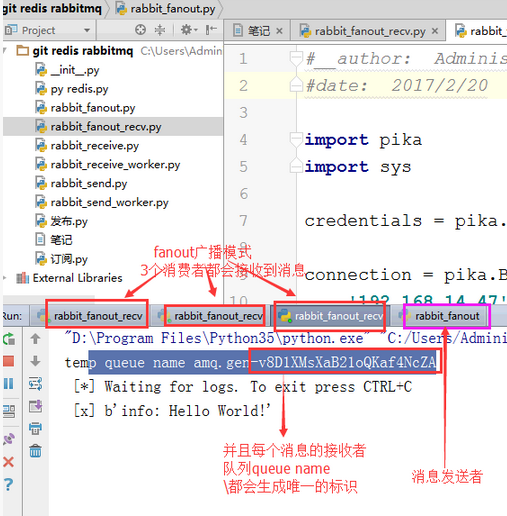消息队列系统 -- RabbitMQ
消息队列系统 -- RabbitMQ
RabbitMQ是一个在AMQP基础上完整的,可复用的企业消息系统。他遵循Mozilla Public License开源协议。
MQ全称为Message Queue, 消息队列(MQ)是一种应用程序对应用程序的通信方法。应用程序通过读写出入队列的消息(针对应用程序的数据)来通信,而无需专用连接来链接它们。消 息传递指的是程序之间通过在消息中发送数据进行通信,而不是通过直接调用彼此来通信,直接调用通常是用于诸如远程过程调用的技术。排队指的是应用程序通过 队列来通信。队列的使用除去了接收和发送应用程序同时执行的要求。
RabbitMQ安装
安装配置epel源
$ rpm -ivh http://dl.fedoraproject.org/pub/epel/6/i386/epel-release-6-8.noarch.rpm 安装erlang
$ yum -y install erlang 安装RabbitMQ
$ yum -y install rabbitmq-server
注意:service rabbitmq-server start/stop
安装API
pip install pika
or
easy_install pika
or
源码 https://pypi.python.org/pypi/pika
使用API操作RabbitMQ
基于Queue实现生产者消费者模型
#!/usr/bin/env python
# -*- coding:utf-8 -*-
import Queue
import threading message = Queue.Queue(10) def producer(i):
while True:
message.put(i) def consumer(i):
while True:
msg = message.get() for i in range(12):
t = threading.Thread(target=producer, args=(i,))
t.start() for i in range(10):
t = threading.Thread(target=consumer, args=(i,))
t.start()
对于RabbitMQ来说,生产和消费不再针对内存里的一个Queue对象,而是某台服务器上的RabbitMQ Server实现的消息队列。
#!/usr/bin/env python
import pika # ######################### 生产者 ######################### connection = pika.BlockingConnection(pika.ConnectionParameters(
host='localhost'))
channel = connection.channel() channel.queue_declare(queue='hello') channel.basic_publish(exchange='',
routing_key='hello',
body='Hello World!')
print(" [x] Sent 'Hello World!'")
connection.close() #!/usr/bin/env python
import pika # ########################## 消费者 ########################## connection = pika.BlockingConnection(pika.ConnectionParameters(
host='localhost'))
channel = connection.channel() channel.queue_declare(queue='hello') def callback(ch, method, properties, body):
print(" [x] Received %r" % body) channel.basic_consume(callback,
queue='hello',
no_ack=True) print(' [*] Waiting for messages. To exit press CTRL+C')
channel.start_consuming()
1、acknowledgment 消息不丢失
no-ack = False,如果消费者遇到情况(its channel is closed, connection is closed, or TCP connection is lost)挂掉了,那么,RabbitMQ会重新将该任务添加到队列中。
消费之:
import pika connection = pika.BlockingConnection(pika.ConnectionParameters(
host='10.211.55.4'))
channel = connection.channel() channel.queue_declare(queue='hello') def callback(ch, method, properties, body):
print(" [x] Received %r" % body)
import time
time.sleep(10)
print 'ok'
ch.basic_ack(delivery_tag = method.delivery_tag) channel.basic_consume(callback,
queue='hello',
no_ack=False) print(' [*] Waiting for messages. To exit press CTRL+C')
channel.start_consuming()
2、durable 消息不丢失
生产者
#!/usr/bin/env python
import pika connection = pika.BlockingConnection(pika.ConnectionParameters(host='10.211.55.4'))
channel = connection.channel() # make message persistent
channel.queue_declare(queue='hello', durable=True) channel.basic_publish(exchange='',
routing_key='hello',
body='Hello World!',
properties=pika.BasicProperties(
delivery_mode=2, # make message persistent
))
print(" [x] Sent 'Hello World!'")
connection.close()
消费者
#!/usr/bin/env python
# -*- coding:utf-8 -*-
import pika connection = pika.BlockingConnection(pika.ConnectionParameters(host='10.211.55.4'))
channel = connection.channel() # make message persistent
channel.queue_declare(queue='hello', durable=True) def callback(ch, method, properties, body):
print(" [x] Received %r" % body)
import time
time.sleep(10)
print 'ok'
ch.basic_ack(delivery_tag = method.delivery_tag) channel.basic_consume(callback,
queue='hello',
no_ack=False) print(' [*] Waiting for messages. To exit press CTRL+C')
channel.start_consuming()
3、消息获取顺序
默认消息队列里的数据是按照顺序被消费者拿走,例如:消费者1 去队列中获取 奇数 序列的任务,消费者1去队列中获取 偶数 序列的任务。
channel.basic_qos(prefetch_count=1) 表示谁来谁取,不再按照奇偶数排列
#!/usr/bin/env python
# -*- coding:utf-8 -*-
import pika connection = pika.BlockingConnection(pika.ConnectionParameters(host='10.211.55.4'))
channel = connection.channel() # make message persistent
channel.queue_declare(queue='hello') def callback(ch, method, properties, body):
print(" [x] Received %r" % body)
import time
time.sleep(10)
print 'ok'
ch.basic_ack(delivery_tag = method.delivery_tag) channel.basic_qos(prefetch_count=1) channel.basic_consume(callback,
queue='hello',
no_ack=False) print(' [*] Waiting for messages. To exit press CTRL+C')
channel.start_consuming()
4、发布订阅

发布订阅和简单的消息队列区别在于,发布订阅会将消息发送给所有的订阅者,而消息队列中的数据被消费一次便消失。所以,RabbitMQ实现发布和订阅时,会为每一个订阅者创建一个队列,而发布者发布消息时,会将消息放置在所有相关队列中。
exchange type = fanout
发布者:
#!/usr/bin/env python
import pika
import sys connection = pika.BlockingConnection(pika.ConnectionParameters(
host='localhost'))
channel = connection.channel() channel.exchange_declare(exchange='logs',
type='fanout') message = ' '.join(sys.argv[1:]) or "info: Hello World!"
channel.basic_publish(exchange='logs',
routing_key='',
body=message)
print(" [x] Sent %r" % message)
connection.close()
订阅者:
#!/usr/bin/env python
import pika connection = pika.BlockingConnection(pika.ConnectionParameters(
host='localhost'))
channel = connection.channel() channel.exchange_declare(exchange='logs',
type='fanout') result = channel.queue_declare(exclusive=True)
queue_name = result.method.queue channel.queue_bind(exchange='logs',
queue=queue_name) print(' [*] Waiting for logs. To exit press CTRL+C') def callback(ch, method, properties, body):
print(" [x] %r" % body) channel.basic_consume(callback,
queue=queue_name,
no_ack=True) channel.start_consuming()
5、关键字发送

exchange type = direct
之前事例,发送消息时明确指定某个队列并向其中发送消息,RabbitMQ还支持根据关键字发送,即:队列绑定关键字,发送者将数据根据关键字发送到消息exchange,exchange根据 关键字 判定应该将数据发送至指定队列。
消费者:
#!/usr/bin/env python
import pika
import sys connection = pika.BlockingConnection(pika.ConnectionParameters(
host='localhost'))
channel = connection.channel() channel.exchange_declare(exchange='direct_logs',
type='direct') result = channel.queue_declare(exclusive=True)
queue_name = result.method.queue severities = sys.argv[1:]
if not severities:
sys.stderr.write("Usage: %s [info] [warning] [error]\n" % sys.argv[0])
sys.exit(1) for severity in severities:
channel.queue_bind(exchange='direct_logs',
queue=queue_name,
routing_key=severity) print(' [*] Waiting for logs. To exit press CTRL+C') def callback(ch, method, properties, body):
print(" [x] %r:%r" % (method.routing_key, body)) channel.basic_consume(callback,
queue=queue_name,
no_ack=True) channel.start_consuming()
生产者:
#!/usr/bin/env python
import pika
import sys connection = pika.BlockingConnection(pika.ConnectionParameters(
host='localhost'))
channel = connection.channel() channel.exchange_declare(exchange='direct_logs',
type='direct') severity = sys.argv[1] if len(sys.argv) > 1 else 'info'
message = ' '.join(sys.argv[2:]) or 'Hello World!'
channel.basic_publish(exchange='direct_logs',
routing_key=severity,
body=message)
print(" [x] Sent %r:%r" % (severity, message))
connection.close()
6、模糊匹配

exchange type = topic
在topic类型下,可以让队列绑定几个模糊的关键字,之后发送者将数据发送到exchange,exchange将传入”路由值“和 ”关键字“进行匹配,匹配成功,则将数据发送到指定队列。
- # 表示可以匹配 0 个 或 多个 单词
- * 表示只能匹配 一个 单词
发送者路由值 队列中
old.boy.python old.* -- 不匹配
old.boy.python old.# -- 匹配
消费者
#!/usr/bin/env python
import pika
import sys connection = pika.BlockingConnection(pika.ConnectionParameters(
host='localhost'))
channel = connection.channel() channel.exchange_declare(exchange='topic_logs',
type='topic') result = channel.queue_declare(exclusive=True)
queue_name = result.method.queue binding_keys = sys.argv[1:]
if not binding_keys:
sys.stderr.write("Usage: %s [binding_key]...\n" % sys.argv[0])
sys.exit(1) for binding_key in binding_keys:
channel.queue_bind(exchange='topic_logs',
queue=queue_name,
routing_key=binding_key) print(' [*] Waiting for logs. To exit press CTRL+C') def callback(ch, method, properties, body):
print(" [x] %r:%r" % (method.routing_key, body)) channel.basic_consume(callback,
queue=queue_name,
no_ack=True) channel.start_consuming()
生产者:
#!/usr/bin/env python
import pika
import sys connection = pika.BlockingConnection(pika.ConnectionParameters(
host='localhost'))
channel = connection.channel() channel.exchange_declare(exchange='topic_logs',
type='topic') routing_key = sys.argv[1] if len(sys.argv) > 1 else 'anonymous.info'
message = ' '.join(sys.argv[2:]) or 'Hello World!'
channel.basic_publish(exchange='topic_logs',
routing_key=routing_key,
body=message)
print(" [x] Sent %r:%r" % (routing_key, message))
connection.close()
实例测试:

topic 执行过滤

消息队列系统 -- RabbitMQ的更多相关文章
- 【翻译】DotNetMQ: 一个.NET版完整的消息队列系统
在一个大型的分布式系统中,消息队列是不可缺少的中间件,能很好的解决异步消息.应用解耦.均衡并发等问题.在.net中,偶然发现一个效率不错.安全可靠.功能齐全的消息组件,忍不住翻译过来,供大家快速预览. ...
- Spring Boot 揭秘与实战(六) 消息队列篇 - RabbitMQ
文章目录 1. 什么是 RabitMQ 2. Spring Boot 整合 RabbitMQ 3. 实战演练4. 源代码 3.1. 一个简单的实战开始 3.1.1. Configuration 3.1 ...
- 消息队列之 RabbitMQ
https://www.jianshu.com/p/79ca08116d57 关于消息队列,从前年开始断断续续看了些资料,想写很久了,但一直没腾出空,近来分别碰到几个朋友聊这块的技术选型,是时候把这块 ...
- RabbitMQ,Apache的ActiveMQ,阿里RocketMQ,Kafka,ZeroMQ,MetaMQ,Redis也可实现消息队列,RabbitMQ的应用场景以及基本原理介绍,RabbitMQ基础知识详解,RabbitMQ布曙
消息队列及常见消息队列介绍 2017-10-10 09:35操作系统/客户端/人脸识别 一.消息队列(MQ)概述 消息队列(Message Queue),是分布式系统中重要的组件,其通用的使用场景可以 ...
- 转 消息队列之 RabbitMQ
转 https://www.jianshu.com/p/79ca08116d57 消息队列之 RabbitMQ 预流 2017.05.06 16:03* 字数 4884 阅读 80990评论 18喜欢 ...
- 快速入门分布式消息队列之 RabbitMQ(2)
目录 目录 前文列表 RabbitMQ 的特性 Message Acknowledgment 消息应答 Prefetch Count 预取数 RPC 远程过程调用 vhost 虚拟主机 插件系统 最后 ...
- 快速入门分布式消息队列之 RabbitMQ(1)
目录 目录 前言 简介 安装 RabbitMQ 基本对象概念 Message 消息 Producer 生产者 Consumer 消费者 Queue 队列 Exchange 交换机 Binding 绑定 ...
- 消息队列,RabbitMQ、Kafka、RocketMQ
目录 1.消息列队概述 1.1消息队列MQ 1.2AMQP和JMS 1.2.1AMQP 1.2.2JMS 1.2.3AMOP 与 JMS 区别 1.3消息队列产品 1.3.1 Kafka 1.3.2 ...
- 消息队列之rabbitmq学习使用
消息队列之rabbitmq学习使用 1.RabbitMQ简介 1.1.什么是RabbitMQ? RabbitMQ是一个开源的消息代理和队列服务器,用来通过普通协议在完全不同的应用之间共享数据,Rabb ...
随机推荐
- react native项目的创建和运行
1.创建项目 react-native init projectName 2.运行项目 在AndroidStudio上运行安卓模拟器 cd projectName react-native run-a ...
- vue中的前置守卫
前置守卫是为了验证用户信息真实性,一些内容只能在用户登陆以后才能进行查看,例如个人中心,我的购物车,等个人页面,非隐私页面 用router.beforeEach进行验证,这个方法必须写在router实 ...
- JS如何创建对象
js创建对象的方法很多,以下分别介绍
- ActiveMQ -5.9和jms-1.1源码下载
ActiveMQ-5.9和jms-1.1源码下载:见附件
- 【慕课网实战】Spark Streaming实时流处理项目实战笔记一之铭文升级版
第一章:课程介绍 铭文一级: VMware Fusion Mac上搭建:为了给大家演示如何使用我们的OOTB环境 Hadoop环境:虚拟机,我是远程登录 Mac 那么就不需要使用我们的OOTB环境 V ...
- linux下运算的几种方法
1.expr 1.1 最简单的用法 yan@yan:~$ \* yan@yan:~$ 1.2 bash脚本对于expr yan@yan:~$ cat expr1.sh #!/bin/bash PATH ...
- 1098 Insertion or Heap Sort
1098 Insertion or Heap Sort (25 分) According to Wikipedia: Insertion sort iterates, consuming one in ...
- (树状数组+离散化)lines--hdu --5124
http://acm.hdu.edu.cn/showproblem.php?pid=5124 lines Time Limit: 5000/2500 MS (Java/Others) Memor ...
- 10.DataGrid的特性
- cpu信息查看
# 总核数 = 物理CPU个数 X 每颗物理CPU的核数 # 总逻辑CPU数 = 物理CPU个数 X 每颗物理CPU的核数 X 超线程数 # 查看物理CPU个数 cat /proc/cpuinfo| ...
